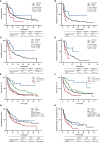Clinicopathologic analysis of nodal T-follicular helper cell lymphomas, a multicenter retrospective study from China
- PMID: 38601148
- PMCID: PMC11004360
- DOI: 10.3389/fimmu.2024.1371534
Clinicopathologic analysis of nodal T-follicular helper cell lymphomas, a multicenter retrospective study from China
Abstract
Background: Nodal T-follicular helper cell lymphomas (nTFHLs) represent a new family of peripheral T-cell lymphomas (PTCLs), and comparative studies of their constituents are rare.
Methods: This study retrospectively enrolled 10 patients with nTFHL-F and 30 patients with nTFHL-NOS diagnosed between December 2017 and October 2023 at six large comprehensive tertiary hospitals; 188 patients with nTFHL-AI were diagnosed during the same period at the First Affiliated Hospital of Zhengzhou University for comparison.
Results: Compared with nTFHL-AI, nTFHL-NOS patients exhibited better clinical manifestations, lower TFH expression levels, and a lower Ki-67 index. However, no differences in clinicopathological features were observed between nTFHL-F and nTFHL-AI patients as well as nTFHL-NOS patients. According to the survival analysis, the median OS for patients with nTFHL-NOS, nTFHL-AI, and nTFHL-F were 14.2 months, 10 months, and 5 months, respectively, whereas the median TTP were 14 months, 5 months, and 3 months, respectively. Statistical analysis revealed differences in TTP among the three subtypes(P=0.0173). Among the population of patients receiving CHOP-like induction therapy, there were significant differences in the OS and TTP among the nTFHL-NOS, nTFHL-AI, and nTFHL-F patients (P=0.0134, P=0.0205). Both the GDPT and C-PET regimens significantly improved the ORR, OS, and PFS in nTFHL patients.
Conclusion: There are significant differences in the clinical manifestations, pathology, and survival outcomes among the three subtypes of nTFHLs. However, further research with a larger sample size, and involving clinical pathology and molecular genetics is needed to determine the distinctive biological characteristics of these tumors.
Keywords: clinical features; clinicopathology; nodal T-follicular helper cell lymphoma; peripheral T-cell lymphoma; prognostic analysis.
Copyright © 2024 Ma, Li, Zuo, Li, Wang, Liu, Wang, Sang, Wang, Zhang and Zhang.
Conflict of interest statement
The authors declare that the research was conducted in the absence of any commercial or financial relationships that could be construed as a potential conflict of interest.
Figures




Similar articles
-
Clinicopathological implications of immunohistochemical expression of TBX21, CXCR3, GATA3, CCR4, and TCF1 in nodal follicular helper T-cell lymphoma and peripheral T-cell lymphoma, not otherwise specified.J Pathol Transl Med. 2024 Mar;58(2):59-71. doi: 10.4132/jptm.2024.01.04. Epub 2024 Jan 22. J Pathol Transl Med. 2024. PMID: 38247153 Free PMC article.
-
[Nodal T-follicular helper cell lymphoma, angioimmunoblastic-type associated with diffuse large B-cell lymphoma: a clinicopathological study].Zhonghua Bing Li Xue Za Zhi. 2023 Sep 8;52(9):918-923. doi: 10.3760/cma.j.cn112151-20221206-01024. Zhonghua Bing Li Xue Za Zhi. 2023. PMID: 37670621 Chinese.
-
Distinct and overlapping features of nodal peripheral T-cell lymphomas exhibiting a follicular helper T-cell phenotype: a multicenter study emphasizing the clinicopathological significance of follicular helper T-cell marker expression.Hum Pathol. 2023 Jan;131:47-60. doi: 10.1016/j.humpath.2022.12.003. Epub 2022 Dec 8. Hum Pathol. 2023. PMID: 36495942
-
Classification and diagnostic evaluation of nodal T- and NK-cell lymphomas.Virchows Arch. 2023 Jan;482(1):265-279. doi: 10.1007/s00428-022-03412-6. Epub 2022 Oct 10. Virchows Arch. 2023. PMID: 36210383 Review.
-
Follicular T-cell lymphoma: a member of an emerging family of follicular helper T-cell derived T-cell lymphomas.Hum Pathol. 2012 Nov;43(11):1789-98. doi: 10.1016/j.humpath.2012.05.002. Epub 2012 Sep 5. Hum Pathol. 2012. PMID: 22959759 Review.
Cited by
-
Complete hematologic response in a patient with multiple pretreated angioimmunoblastic T-cell lymphoma after belinostat therapy followed by allogeneic stem cell transplantation: A case report.Clin Case Rep. 2024 Jul 7;12(7):e9159. doi: 10.1002/ccr3.9159. eCollection 2024 Jul. Clin Case Rep. 2024. PMID: 38979088 Free PMC article.
References
-
- de Leval L, Rickman DS, Thielen C, Reynies A, Huang YL, Delsol G, et al. . The gene expression profile of nodal peripheral T-cell lymphoma demonstrates a molecular link between angioimmunoblastic T-cell lymphoma (AITL) and follicular helper T (TFH) cells. Blood. (2007) 109:4952–63. doi: 10.1182/blood-2006-10-055145 - DOI - PubMed
-
- Dobay MP, Lemonnier F, Missiaglia E, Bastard C, Vallois D, Jais JP, et al. . Integrative clinicopathological and molecular analyses of angioimmunoblastic T-cell lymphoma and other nodal lymphomas of follicular helper T-cell origin. Haematologica. (2017) 102:e148–51. doi: 10.3324/haematol.2016.158428 - DOI - PMC - PubMed
Publication types
MeSH terms
LinkOut - more resources
Full Text Sources
Research Materials

